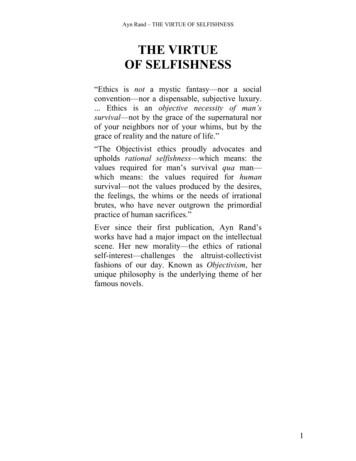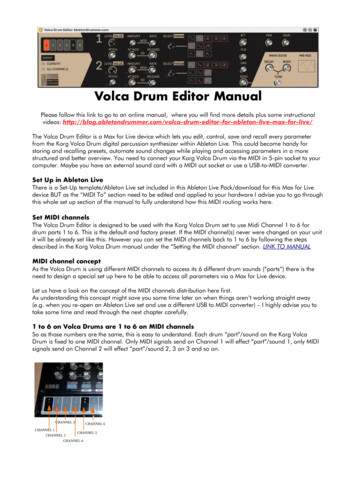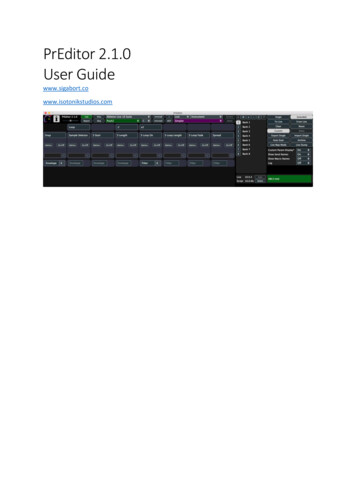
Transcription
2T H E M Y T H O F C H A R I S M AT I C L E A D E R S H I PThe Culture of Personality, a Hundred Years LaterSociety is itself an education in the extrovert values, and rarely has therebeen a society that has preached them so hard. No man is an island, buthow John Donne would writhe to hear how often, and for what reasons,the thought is so tiresomely repeated.—william whyteSalesmanship as a Virtue: Live with Tony Robbins“Are you excited?” cries a young woman named Stacy as I hand her myregistration forms. Her honeyed voice rises into one big exclamationpoint. I nod and smile as brightly as I can. Across the lobby of the Atlanta Convention Center, I hear people shrieking.“What’s that noise?” I ask.“They’re getting everyone pumped up to go inside!” Stacy enthuses.“That’s part of the whole UPW experience.” She hands me a purple spiral binder and a laminated nametag to wear around my neck. UNLEASHTHE POWER WITHIN, proclaims the binder in big block letters. Welcome to Tony Robbins’s entry-level seminar.I’ve paid 895 in exchange, according to the promotional materials,for learning how to be more energetic, gain momentum in my life, andconquer my fears. But the truth is that I’m not here to unleash the power260Z TXT.indd 3407/12/2011 17:15
t he myt h o f c ha r is mat i c l e ade r s h i p 35within me (though I’m always happy to pick up a few pointers); I’m herebecause this seminar is the first stop on my journey to understand theExtrovert Ideal.I’ve seen Tony Robbins’s infomercials—he claims that there’s alwaysone airing at any given moment—and he strikes me as one of the moreextroverted people on earth. But he’s not just any extrovert. He’s theking of self-help, with a client roster that has included President Clinton, Tiger Woods, Nelson Mandela, Margaret Thatcher, Princess Diana,Mikhail Gorbachev, Mother Teresa, Serena Williams, Donna Karan—and 50 million other people. And the self-help industry, into which hundreds of thousands of Americans pour their hearts, souls, and some 11billion a year, by definition reveals our conception of the ideal self, theone we aspire to become if only we follow the seven principles of thisand the three laws of that. I want to know what this ideal self looks like.Stacy asks if I’ve brought my meals with me. It seems a strange question: Who carries supper with them from New York City to Atlanta? Sheexplains that I’ll want to refuel at my seat; for the next four days, Fridaythrough Monday, we’ll be working fifteen hours a day, 8:00 a.m. to 11:00p.m., with only one short afternoon break. Tony will be onstage the entiretime and I won’t want to miss a moment.I look around the lobby. Other people seem to have come prepared—they’re strolling toward the hall, cheerfully lugging grocery bags stuffedwith PowerBars, bananas, and corn chips. I pick up a couple of bruisedapples from the snack bar and make my way to the auditorium. Greeterswearing UPW T-shirts and ecstatic smiles line the entrance, springing upand down, fists pumping. You can’t get inside without slapping them five.I know, because I try.Inside the vast hall, a phalanx of dancers is warming up the crowd tothe Billy Idol song “Mony Mony,” amplified by a world-class sound system, magnified on giant Megatron screens flanking the stage. They movein sync like backup dancers in a Britney Spears video, but are dressed likemiddle managers. The lead performer is a fortysomething balding fellowwearing a white button-down shirt, conservative tie, rolled-up sleeves,and a great-to-meet-you smile. The message seems to be that we can alllearn to be this exuberant when we get to work every morning.Indeed, the dance moves are simple enough for us to imitate at our260Z TXT.indd 3507/12/2011 17:15
36 Q uietseats: jump and clap twice; clap to the left; clap to the right. When thesong changes to “Gimme Some Lovin’,” many in the audience climbatop their metal folding chairs, where they continue to whoop and clap.I stand somewhat peevishly with arms crossed until I decide that there’snothing to be done but join in and hop up and down along with myseatmates.Eventually the moment we’ve all been waiting for arrives: TonyRobbins bounds onstage. Already gigantic at six feet seven inches, helooks a hundred feet tall on the Megatron screen. He’s movie-star handsome, with a head of thick brown hair, a Pepsodent smile, and impossiblydefined cheekbones. EXPERIENCE TONY ROBBINS LIVE! the seminar advertisement had promised, and now here he is, dancing with theeuphoric crowd.It’s about fifty degrees in the hall, but Tony is wearing a short-sleevedpolo shirt and shorts. Many in the audience have brought blanketswith them, having somehow known that the auditorium would be keptrefrigerator-cold, presumably to accommodate Tony’s high-octane metabolism. It would take another Ice Age to cool this man off. He’s leaping and beaming and managing, somehow, to make eye contact with all3,800 of us. The greeters jump rapturously in the aisles. Tony opens hisarms wide, embracing us all. If Jesus returned to Earth and made his firststop at the Atlanta Convention Center, it would be hard to imagine amore jubilant reception.This is true even in the back row where I’m sitting with others whospent only 895 for “general admission,” as opposed to 2,500 for a “Diamond Premiere Membership,” which gets you a seat up front, as closeto Tony as possible. When I bought my ticket over the phone, the account rep advised me that the people in the front rows—where “you’relooking directly at Tony for sure” instead of relying on the Megatron—are generally “more successful in life.” “Those are the people who havemore energy,” she advised. “Those are the people who are screaming.”I have no way of judging how successful the people next to me are, butthey certainly seem thrilled to be here. At the sight of Tony, exquisitelystage-lit to set off his expressive face, they cry out and pour into the aislesrock-concert style.Soon enough, I join them. I’ve always loved to dance, and I have to260Z TXT.indd 3607/12/2011 17:15
t he m yt h o f c ha r is mat i c l e ade r s h i p 37admit that gyrating en masse to Top 40 classics is an excellent way to passthe time. Unleashed power comes from high energy, according to Tony,and I can see his point. No wonder people travel from far and wide to seehim in person (there’s a lovely young woman from Ukraine sitting—no,leaping—next to me with a delighted smile). I really must start doingaerobics again when I get back to New York, I decide. When the music finally stops, Tony addresses us in a raspy voice, halfMuppet, half bedroom-sexy, introducing his theory of “Practical Psychology.” The gist of it is that knowledge is useless until it’s coupled withaction. He has a seductive, fast-talking delivery that Willy Loman wouldhave sighed over. Demonstrating practical psychology in action, Tonyinstructs us to find a partner and to greet each other as if we feel inferiorand scared of social rejection. I team up with a construction worker fromdowntown Atlanta, and we extend tentative handshakes, looking bashfully at the ground as the song “I Want You to Want Me” plays in thebackground.Then Tony calls out a series of artfully phrased questions:“Was your breath full or shallow?”“SHALLOW!” yells the audience in unison.“Did you hesitate or go straight toward them?”“HESITATE!”“Was there tension in your body or were you relaxed?”“TENSION!”Tony asks us to repeat the exercise, but this time to greet our partnersas if the impression we make in the first three to five seconds determineswhether they’ll do business with us. If they don’t, “everyone you careabout will die like pigs in hell.”I’m startled by Tony’s emphasis on business success—this is a seminarabout personal power, not sales. Then I remember that Tony is not onlya life coach but also a businessman extraordinaire; he started his careerin sales and today serves as chairman of seven privately held companies.260Z TXT.indd 3707/12/2011 17:15
38 Q uietBusinessWeek once estimated his income at 80 million a year. Now heseems to be trying, with all the force of his mighty personality, to imparthis salesman’s touch. He wants us not only to feel great but to radiatewaves of energy, not just to be liked, but to be well liked; he wants us toknow how to sell ourselves. I’ve already been advised by the AnthonyRobbins Companies, via a personalized forty-five-page report generatedby an online personality test that I took in preparation for this weekend,that “Susan” should work on her tendency to tell, not sell, her ideas.(The report was written in the third person, as if it was to be reviewed bysome imaginary manager evaluating my people skills.)The audience divides into pairs again, enthusiastically introducingthemselves and pumping their partners’ hands. When we’re finished, thequestions repeat.“Did that feel better, yes or no?”“YES!”“Did you use your body differently, yes or no?”“YES!”“Did you use more muscles in your face, yes or no?”“YES!”“Did you move straight toward them, yes or no?”“YES!”This exercise seems designed to show how our physiological stateinfluences our behavior and emotions, but it also suggests that salesmanship governs even the most neutral interactions. It implies that everyencounter is a high-stakes game in which we win or lose the other person’s favor. It urges us to meet social fear in as extroverted a manner aspossible. We must be vibrant and confident, we must not seem hesitant,we must smile so that our interlocutors will smile upon us. Taking thesesteps will make us feel good—and the better we feel, the better we cansell ourselves.Tony seems the perfect person to demonstrate such skills. He strikesme as having a “hyperthymic” temperament—a kind of extroversionon-steroids characterized, in the words of one psychiatrist, by “exuberant, upbeat, overenergetic, and overconfident lifelong traits” that havebeen recognized as an asset in business, especially sales. People with thesetraits often make wonderful company, as Tony does onstage.260Z TXT.indd 3807/12/2011 17:15
t he myt h o f c ha r is mat i c l e ade r s h i p 39But what if you admire the hyperthymic among us, but also like yourcalm and thoughtful self? What if you love knowledge for its own sake,not necessarily as a blueprint to action? What if you wish there weremore, not fewer, reflective types in the world?Tony seems to have anticipated such questions. “But I’m not an extrovert, you say!” he told us at the start of the seminar. “So? You don’thave to be an extrovert to feel alive!”True enough. But it seems, according to Tony, that you’d better actlike one if you don’t want to flub the sales call and watch your family dielike pigs in hell. The evening culminates with the Firewalk, one of the flagship momentsof the UPW seminar, in which we’re challenged to walk across a ten-footbed of coals without burning our feet. Many people attend UPW becausethey’ve heard about the Firewalk and want to try it themselves. The ideais to propel yourself into such a fearless state of mind that you can withstand even 1,200-degree heat.Leading up to that moment, we spend hours practicing Tony’stechniques—exercises, dance moves, visualizations. I notice that people in the audience are starting to mimic Tony’s every movement andfacial expression, including his signature gesture of pumping his armas if he were pitching a baseball. The evening crescendoes until finally, just before midnight, we march to the parking lot in a torchlitprocession, nearly four thousand strong, chanting YES! YES! YES! tothe thump of a tribal beat. This seems to electrify my fellow UPWers,but to me this drum-accompanied chant—YES! Ba-da-da-da, YES!Dum-dum-dum-DUM, YES! Ba-da-da-da—sounds like the sort of thinga Roman general would stage to announce his arrival in the city he’sabout to sack. The greeters who manned the gates to the auditoriumearlier in the day with high fives and bright smiles have morphed intogatekeepers of the Firewalk, arms beckoning toward the bridge of flames.As best I can tell, a successful Firewalk depends not so much on your260Z TXT.indd 3907/12/2011 17:15
40 Q uietstate of mind as on how thick the soles of your feet happen to be, so Iwatch from a safe distance. But I seem to be the only one hanging back.Most of the UPWers make it across, whooping as they go.“I did it!” they cry when they get to the other side of the firepit. “Idid it!”They’ve entered a Tony Robbins state of mind. But what exactlydoes this consist of?It is, first and foremost, a superior mind—the antidote to AlfredAdler’s inferiority complex. Tony uses the word power rather than superior (we’re too sophisticated nowadays to frame our quests for selfimprovement in terms of naked social positioning, the way we did atthe dawn of the Culture of Personality), but everything about him is anexercise in superiority, from the way he occasionally addresses the audience as “girls and boys,” to the stories he tells about his big houses andpowerful friends, to the way he towers—literally—over the crowd. Hissuperhuman physical size is an important part of his brand; the title of hisbest-selling book, Awaken the Giant Within, says it all.His intellect is impressive, too. Though he believes university educations are overrated (because they don’t teach you about your emotions and your body, he says) and has been slow to write his next book(because no one reads anymore, according to Tony), he’s managed toassimilate the work of academic psychologists and package it into onehell of a show, with genuine insights the audience can make their own.Part of Tony’s genius lies in the unstated promise that he’ll let theaudience share his own journey from inferiority to superiority. He wasn’talways so grand, he tells us. As a kid, he was a shrimp. Before he got inshape, he was overweight. And before he lived in a castle in Del Mar,California, he rented an apartment so small that he kept his dishes in thebathtub. The implication is that we can all get over whatever’s keepingus down, that even introverts can learn to walk on coals while beltingout a lusty YES.The second part of the Tony state of mind is good-heartedness. Hewouldn’t inspire so many people if he didn’t make them feel that hetruly cared about unleashing the power within each of them. WhenTony’s onstage, you get the sense that he’s singing, dancing, and emotingwith every ounce of his energy and heart. There are moments, when the260Z TXT.indd 4007/12/2011 17:15
t he m yt h o f c ha r is mat i c l e ade r s h i p 41crowd is on its feet, singing and dancing in unison, that you can’t helpbut love him, the way many people loved Barack Obama with a kindof shocked delight when they first heard him talk about transcendingred and blue. At one point, Tony talks about the different needs peoplehave—for love, certainty, variety, and so on. He is motivated by love, hetells us, and we believe him.But there’s also this: throughout the seminar, he constantly tries to“upsell” us. He and his sales team use the UPW event, whose attendees have already paid a goodly sum, to market multi-day seminars witheven more alluring names and stiffer price tags: Date with Destiny, about 5,000; Mastery University, about 10,000; and the Platinum Partnership, which, for a cool 45,000 a year, buys you and eleven other Platinum Partners the right to go on exotic vacations with Tony.During the afternoon break, Tony lingers onstage with his blondand sweetly beautiful wife, Sage, gazing into her eyes, caressing her hair,murmuring into her ear. I’m happily married, but right now Ken is inNew York and I’m here in Atlanta, and even I feel lonely as I watch thisspectacle. What would it be like if I were single or unhappily partnered?It would “arouse an eager want” in me, just as Dale Carnegie advisedsalesmen to do with their prospects so many years ago. And sure enough,when the break is over, a lengthy video comes on the mega-screen, pitching Tony’s relationship-building seminar.In another brilliantly conceived segment, Tony devotes part of theseminar to explaining the financial and emotional benefits of surrounding oneself with the right “peer group”—after which a staffer begins asales pitch for the 45,000 Platinum program. Those who purchase oneof the twelve spots will join the “ultimate peer group,” we are told—the“cream of the crop,” the “elite of the elite of the elite.”I can’t help but wonder why none of the other UPWers seem tomind, or even to notice, these upselling techniques. By now many ofthem have shopping bags at their feet, full of stuff they bought out in thelobby—DVDs, books, even eight-by-ten glossies of Tony himself, readyfor framing.But the thing about Tony—and what draws people to buy hisproducts—is that like any good salesman, he believes in what he’s pitching. He apparently sees no contradiction between wanting the best for260Z TXT.indd 4107/12/2011 17:15
42 Q uietpeople and wanting to live in a mansion. He persuades us that he’s usinghis sales skills not only for personal gain but also to help as many of us ashe can reach. Indeed, one very thoughtful introvert I know, a successfulsalesman who gives sales training seminars of his own, swears that TonyRobbins not only improved his business but also made him a better person. When he started attending events like UPW, he says, he focused onwho he wanted to become, and now, when he delivers his own seminars,he is that person. “Tony gives me energy,” he says, “and now I can createenergy for other people when I’m onstage.” At the onset of the Culture of Personality, we were urged to developan extroverted personality for frankly selfish reasons—as a way of outshining the crowd in a newly anonymous and competitive society. Butnowadays we tend to think that becoming more extroverted not onlymakes us more successful, but also makes us better people. We see salesmanship as a way of sharing one’s gifts with the world.This is why Tony’s zeal to sell to and be adulated by thousands ofpeople at once is seen not as narcissism or hucksterism, but as leadershipof the highest order. If Abraham Lincoln was the embodiment of virtueduring the Culture of Character, then Tony Robbins is his counterpartduring the Culture of Personality. Indeed, when Tony mentions that heonce thought of running for president of the United States, the audienceerupts in loud cheers.But does it always make sense to equate leadership with hyperextroversion? To find out, I visited Harvard Business School, an institution that prides itself on its ability to identify and train some of the mostprominent business and political leaders of our time.260Z TXT.indd 4207/12/2011 17:15
t he myt h o f c ha r is mat i c l e ade r s h i p 43The Myth of Charismatic Leadership: Harvard BusinessSchool and BeyondThe first thing I notice about the Harvard Business School campus is theway people walk. No one ambles, strolls, or lingers. They stride, full of forward momentum. It’s crisp and autumnal the week I visit, and the students’bodies seem to vibrate with September electricity as they advance acrosscampus. When they cross each other’s paths they don’t merely nod—theyexchange animated greetings, inquiring about this one’s summer with J. P.Morgan or that one’s trek in the Himalayas.They behave the same way inside the social hothouse of the SpanglerCenter, the sumptuously decorated student center. Spangler has floor-toceiling silk curtains in sea-foam green, rich leather sofas, giant Samsunghigh-definition TVs silently broadcasting campus news, and soaring ceilings festooned with high-wattage chandeliers. The tables and sofas areclustered mostly on the perimeter of the room, forming a brightly lit center catwalk down which the students breezily parade, seemingly unawarethat all eyes are on them. I admire their nonchalance.The students are even better turned out than their surroundings, ifsuch a thing is possible. No one is more than five pounds overweight orhas bad skin or wears odd accessories. The women are a cross betweenHead Cheerleader and Most Likely to Succeed. They wear fitted jeans,filmy blouses, and high-heeled peekaboo-toed shoes that make a pleasing clickety–clack on Spangler’s polished wood floors. Some parade likefashion models, except that they’re social and beaming instead of aloofand impassive. The men are clean-cut and athletic; they look like peoplewho expect to be in charge, but in a friendly, Eagle Scout sort of way. Ihave the feeling that if you asked one of them for driving directions, he’dgreet you with a can-do smile and throw himself into the task of helpingyou to your destination—whether or not he knew the way.I sit down next to a couple of students who are in the middle of planning a road trip—HBS students are forever coordinating pub crawls andparties, or describing an extreme-travel junket they’ve just come backfrom. When they ask what brings me to campus, I say that I’m conducting interviews for a book about introversion and extroversion. I don’t tellthem that a friend of mine, himself an HBS grad, once called the place260Z TXT.indd 4307/12/2011 17:15
44 Q uietthe “Spiritual Capital of Extroversion.” But it turns out that I don’t haveto tell them.“Good luck finding an introvert around here,” says one.“This school is predicated on extroversion,” adds the other. “Yourgrades and social status depend on it. It’s just the norm here. Everyonearound you is speaking up and being social and going out.”“Isn’t there anyone on the quieter side?” I ask.They look at me curiously.“I couldn’t tell you,” says the first student dismissively. Harvard Business School is not, by any measure, an ordinary place.Founded in 1908, just when Dale Carnegie hit the road as a travelingsalesman and only three years before he taught his first class in publicspeaking, the school sees itself as “educating leaders who make a difference in the world.” President George W. Bush is a graduate, as are an impressive collection of World Bank presidents, U.S. Treasury secretaries,New York City mayors, CEOs of companies like General Electric, Goldman Sachs, Procter & Gamble, and, more notoriously, Jeffrey Skilling,the villain of the Enron scandal. Between 2004 and 2006, 20 percent ofthe top three executives at the Fortune 500 companies were HBS grads.HBS grads likely have influenced your life in ways you’re not awareof. They have decided who should go to war and when; they have resolved the fate of Detroit’s auto industry; they play leading roles in justabout every crisis to shake Wall Street, Main Street, and PennsylvaniaAvenue. If you work in corporate America, there’s a good chance thatHarvard Business School grads have shaped your everyday life, too,weighing in on how much privacy you need in your workspace, howmany team-building sessions you need to attend per year, and whethercreativity is best achieved through brainstorming or solitude. Given thescope of their influence, it’s worth taking a look at who enrolls here—and what they value by the time they graduate.260Z TXT.indd 4407/12/2011 17:15
t he myt h o f c ha r is mat i c l e ade r s h i p 45The student who wishes me luck in finding an introvert at HBS nodoubt believes that there are none to be found. But clearly he doesn’tknow his first-year classmate Don Chen. I first meet Don in Spangler,where he’s seated only a few couches away from the road-trip planners.He comes across as a typical HBS student, tall, with gracious manners,prominent cheekbones, a winsome smile, and a fashionably choppy,surfer-dude haircut. He’d like to find a job in private equity when hegraduates. But talk to Don for a while and you’ll notice that his voice issofter than those of his classmates, his head ever so slightly cocked, hisgrin a little tentative. Don is “a bitter introvert,” as he cheerfully putsit—bitter because the more time he spends at HBS, the more convincedhe becomes that he’d better change his ways.Don likes having a lot of time to himself, but that’s not much ofan option at HBS. His day begins early in the morning, when he meetsfor an hour and a half with his “Learning Team”—a pre-assigned studygroup in which participation is mandatory (students at HBS practicallygo to the bathroom in teams). He spends the rest of the morning inclass, where ninety students sit together in a wood-paneled, U-shapedamphitheater with stadium seating. The professor usually kicks off bydirecting a student to describe the case study of the day, which is basedon a real-life business scenario—say, a CEO who’s considering changingher company’s salary structure. The figure at the heart of the case study,in this case the CEO, is referred to as the “protagonist.” If you were theprotagonist, the professor asks—and soon you will be, is the implication—what would you do?The essence of the HBS education is that leaders have to act confidently and make decisions in the face of incomplete information. Theteaching method plays with an age-old question: If you don’t have allthe facts—and often you won’t—should you wait to act until you’vecollected as much data as possible? Or, by hesitating, do you risk losingothers’ trust and your own momentum? The answer isn’t obvious. If youspeak firmly on the basis of bad information, you can lead your peopleinto disaster. But if you exude uncertainty, then morale suffers, funderswon’t invest, and your organization can collapse.The HBS teaching method implicitly comes down on the side of260Z TXT.indd 4507/12/2011 17:15
46 Q uietcertainty. The CEO may not know the best way forward, but she has toact anyway. The HBS students, in turn, are expected to opine. Ideally,the student who was just cold-called has already discussed the case studywith his Learning Team, so he’s ready to hold forth on the protagonist’sbest moves. After he finishes, the professor encourages other students tooffer their own views. Half of the students’ grade, and a much larger percentage of their social status, is based on whether they throw themselvesinto this fray. If a student talks often and forcefully, then he’s a player; ifhe doesn’t, he’s on the margins.Many of the students adapt easily to this system. But not Don. Hehas trouble elbowing his way into class discussions; in some classes hebarely speaks at all. He prefers to contribute only when he believes hehas something insightful to add, or honest-to-God disagrees with someone. This sounds reasonable, but Don feels as if he should be more comfortable talking just so he can fill up his share of available airtime.Don’s HBS friends, who tend to be thoughtful, reflective types likehim, spend a lot of time talking about talking in class. How much classparticipation is too much? How little is too little? When does publiclydisagreeing with a classmate constitute healthy debate, and when doesit seem competitive and judgmental? One of Don’s friends is worriedbecause her professor sent around an e-mail saying that anyone withreal-world experience on the day’s case study should let him know inadvance. She’s sure that the professor’s announcement was an effort tolimit stupid remarks like the one she made in class last week. Anotherworries that he’s not loud enough. “I just have a naturally soft voice,” hesays, “so when my voice sounds normal to others, I feel like I’m shouting.I have to work on it.”The school also tries hard to turn quiet students into talkers.The professors have their own “Learning Teams,” in which they eggeach other on with techniques to draw out reticent students. When students fail to speak up in class, it’s seen not only as their own deficit butalso as their professor’s. “If someone doesn’t speak by the end of the semester, it’s problematic,” Professor Michel Anteby told me. “It means Ididn’t do a good job.”The school even hosts live informational sessions and web pages on260Z TXT.indd 4607/12/2011 17:15
t he myt h o f c ha r is mat i c l e ade r s h i p 47how to be a good class participator. Don’s friends earnestly reel off thetips they remember best.“Speak with conviction. Even if you believe something only fifty-fivepercent, say it as if you believe it a hundred percent.”“If you’re preparing alone for class, then you’re doing it wrong. Nothing at HBS is intended to be done alone.”“Don’t think about the perfect answer. It’s better to get out there andsay something than to never get your voice in.”The school newspaper, The Harbus, also dispenses advice, featuringarticles with titles like “How to Think and Speak Well—On the Spot!,”“Developing Your Stage Presence,” and “Arrogant or Simply Confident?”These imperatives extend beyond the classroom. After class, mostpeople eat lunch at the Spangler dining hall, which one grad describes as“more like high school than high school.” And every day, Don wrestleswith himself. Should he go back to his apartment and recharge over aquiet lunch, as he longs to do, or join his classmates? Even if he forceshimself to go to Spangler, it’s not as if the social pressure will end there.As the day wears on, there will be more such dilemmas. Attend thelate-afternoon happy hours? Head out for a late, rowdy evening? Students at HBS go out in big groups several nights a week, says Don. Participation isn’t mandatory, but it feels as if it is to those who don’t thriveon group activities.“Socializing here is an extreme sport,” one of Don’s friends tells me.“People go out all the time. If you don’t go out one night, the next daypeople will ask, ‘Where were you?’ I go out at night like it’s my job.” Donhas noticed that the people who organize social events—happy hours,dinners, drinking fests—are at the top of the social hierarchy. “The professors tell us that our classmates are the people who will go to our weddings,” says Don. “If you leave HBS without having built an extensivesocial network, it’s like you failed your HBS experience.”By the time Don falls into bed at night, he’s exhausted. And sometimes he wonders why, exactly, he should have to work so h
Eventually the moment we’ve all been waiting for arrives: Tony Robbins bounds onstage. Already gigantic at six feet seven inches, he looks a hundred feet tall on the Megatron screen. He’s movie- star hand-some, with a head of thick brown hair, a Pepsodent smile, and impossibly defi ned cheekbones.










